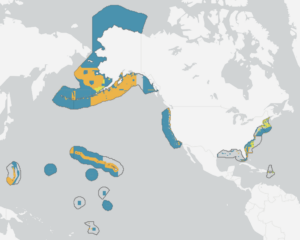
For Immediate Release
June 12, 2023

Conservation areas in the U.S. federal waters
The nation’s eight regional fishery management councils (Councils) have released a first-ever synthesis of conservation areas in federal waters of the United States. The report, located on https://www.fisherycouncils.org/area-based-management, identifies hundreds of conservation areas covering nearly three quarters of federal waters. These findings demonstrate that a large portion of federal waters are protected from fishing activities that could negatively impact the environment.
The report was developed with the goal of identifying conservation areas that should be included in the American Conservation and Stewardship Atlas (Atlas). Development of the Atlas is one component of the Biden Administration’s America the Beautiful initiative, which aims to conserve 30% of U.S. lands and waters by 2030. According to the Biden Administration, the Atlas will be a “tool through which to measure the progress of conservation, stewardship, and restoration efforts across the United States.” The Council Coordination Committee (CCC), consisting of leadership from the eight fishery management councils, formed an Area-Based Management Subcommittee in May 2021 to identify conservation areas in federal waters.
“Our subcommittee produced a first-of-its-kind, groundbreaking, and highly detailed analysis of the conservation areas developed by all eight regional fisheries management councils under our authority mandated by the Magnuson-Stevens Act,” said Eric Reid, Chair of the CCC Area-Based Management Subcommittee. “These conservation areas are designed to maintain the productivity and biodiversity of marine ecosystems and balance fishery access to a wide variety of user groups.”
Areas under consideration were subject to a newly developed, rigorous review process that included defining a “conservation area” and then screening each area relative to qualifying criteria based on a combination of international standards for conservation and the America the Beautiful principles.
Based on those criteria, the subcommittee identified a total of 648 conservation areas covering more than 72%, or nearly 3.4 million square miles, of federal waters. The report includes an in-depth examination of fishing gear restrictions, with a focus on various configurations of “bottom tending” gear which contact the sea floor. According to the report, bottom trawling is prohibited in over half of U.S. federal waters, and over a third of the U.S. federal waters include prohibitions on all bottom tending gears.
Appendix A of the report includes summaries and maps of each Council’s conservation areas. Appendix B provides additional details and links, an evaluation relative to the eight America the Beautiful principles, and an effectiveness checklist. For those interested in exploring the maps more closely, the subcommittee also developed an interactive “dashboard” tool to serve as a companion to the report. The dashboard is a work in progress and will continue to be refined in the months to come.
“The CCC strongly encourages NOAA and other agencies involved in Atlas development to incorporate the conservation areas identified in the report,” said Dr. Greg Stunz, CCC Chair. “By including these areas in the Atlas, the U.S. effectively demonstrates how the Councils’ fishery management measures directly result in improved conservation outcomes that benefit sustainable fisheries, other marine species, and habitats.”
For more information visit the Area-Based Management webpage.
Contact Michelle Bachman or Eric Reid with technical questions about CCC Area-Based Management efforts and products.
Use this list of regional contacts for media inquiries or general questions.
